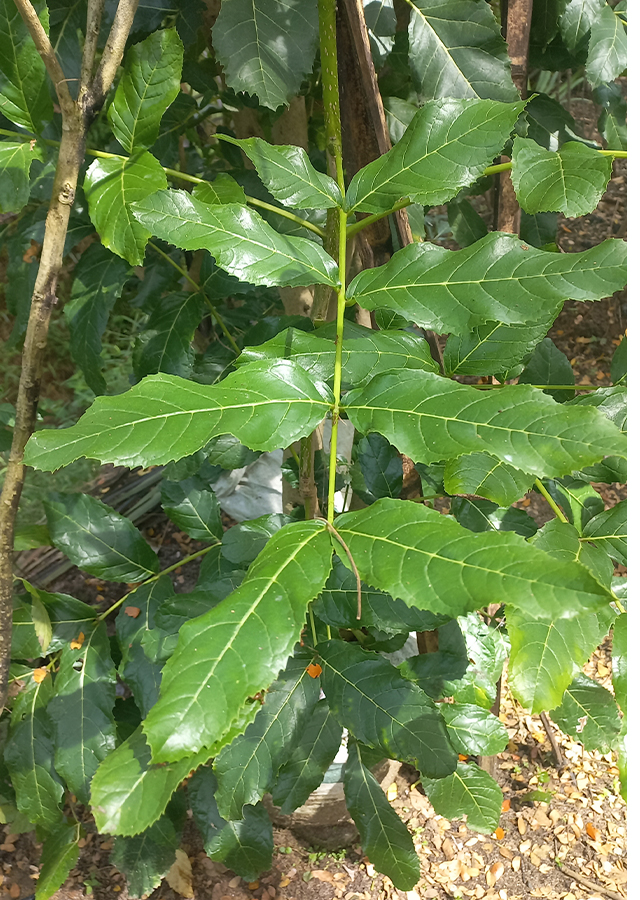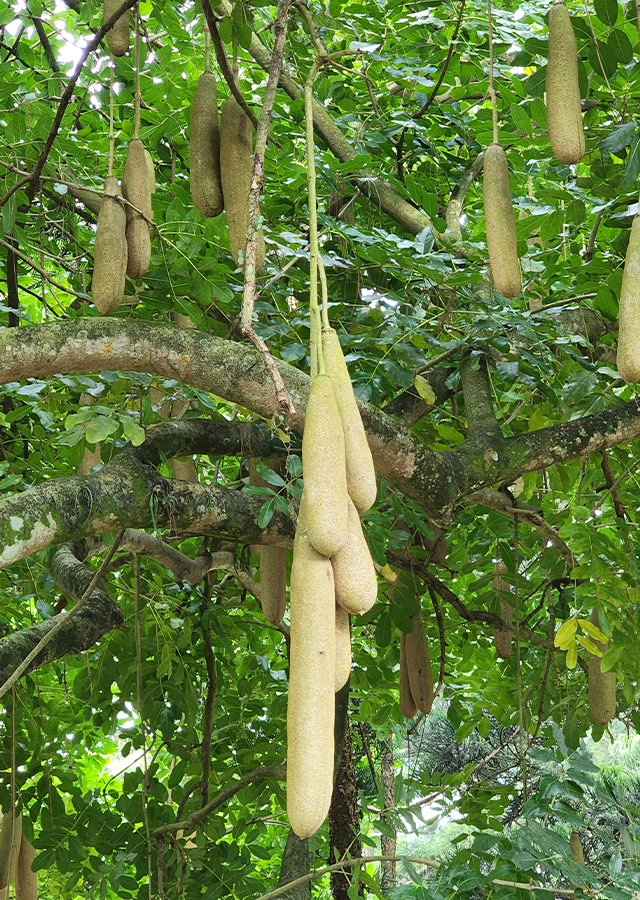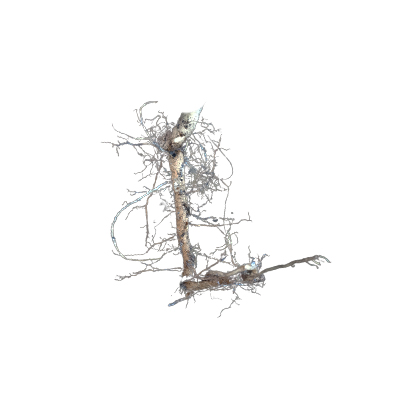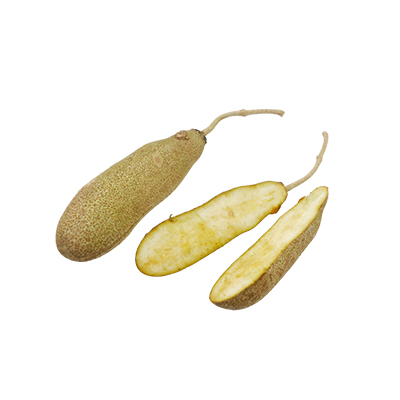African Sausage Tree
Kigelia africana (Lam.) Benth.
Bignoniaceae
Location in our garden
Hardwood



Synonym
Bignonia africana Lam.
Tecoma africana (Lam.) G.Don
Habitus
Trees. An extremely variable, semideciduous tree with a large, dense, spreading crown, sometimes grows up to 23 m tall but is usually smaller
Part Used
Leaves
Bark
Fruit
Roots
Growing Requirements
Full Sunshine
Habitat
Riverbanks
Forest
Roadside
Shrublands
Terrestrial
Overview
The sausage tree or Kigelia africana is a native plant and is widespread throughout tropical Africa. This species has also been introduced to several countries in Africa (Madeira, Canary Islands, Cape Verde, Réunion, Mauritius), United States (California, Florida, and Hawaii), Caribbean islands, Central and South America (Mexico, Honduras, El Salvador, Nicaragua, Costa Rica, Panama, Colombia, Venezuela, French Guiana, Ecuador, Peru, and Brazil), West Asia (Israel, Iraq), South and Southeast Asia (Pakistan, India, Maldives, Sri Lanka, Myanmar, Thailand, Laos, Vietnam, China, Taiwan, Malaysia, Singapore, Indonesia and the Philippines), Australia and some Pacific Islands (New Caledonia, Guam and the Marquesas Islands). Kigelia africana is one of the species that has been widely exploited for its medicinal, religious and cultural values. Has many properties and biological and pharmacological activities. Various parts of the plant are used locally to treat various ailments. In its home country, Kigelia africana is also considered sacred to many communities and is often protected when other forest trees are felled. In Kenya, the Luo and Luhya people bury the fruit to symbolize the bodies of missing persons believed to have died. In addition, Kigelia africana is also widely used by the community as an ornamental plant, florist material (fruit), shade plant, erosion control and riverbank stabilization plant, source material (boards, fence posts, boxes, drums, chairs, tool handles, and others). Black (derived from the pulp) and yellow (from the root) dyes are used as ingredients in the brewing process to aid fermentation and enhance the taste of traditional beers. However, the flesh of the fruit is inedible and poisonous, which can be intoxicating and can cause tongue and skin blisters.
Vernacular Names
Worsboom (Afrikaans), Abu shutor (Arabic), Saucissonnier (French), Leberwurstbaum (German), Arbol De Las Salchichas (Spanish).
Agroecology
A plant of low to higher elevations in the tropics, where it is found at elevations up to 3,000 m. Found growing on rain-forest; guinean and soudanian savannah; usually in damp sites; often riverain. It is found in areas where the mean annual rainfall is in the range 900 - 2,000 mm. Prefers a medium loam soil. Grows best in a sunny position in a fertile, humus-rich, well-drained soil.
Morphology
- Stems - thick, dark gray to light brown, thin scaly, peeling, low branched, branches are spreading and lenticels.
- Leaves - opposite or in whorls of 3, imparipinnate, crowded towards the tips of the branches; leaflets 5-11, opposite, sessile or subsessile except the terminal one with petiolule 1-4(-6.5) cm long, leaflet lamina 3.5-20 x 2.5-11 cm, ovate-elliptic, apex obtuse, broadly tapering to rounded or retuse, base rounded to cuneate, slightly to strongly asymmetric except in the terminal leaflet which is symmetric, glabrous to more or less hairy on both surfaces, margins entire, serrate or toothed and sometimes conspicuously wavy, lateral nerves impressed above and prominent below; petiole 3.5-15 cm long, rhachis sulcate above, terete below.
- Flowers - Inflorescence a pendulous, lax, terminal panicle 30-100(-150) cm long. Flowers zygomorphic, large, longly pedunculate; pedicels 1-11(-13.5) cm long, upcurved at the tip; calyx tubular to campanulate, 2-4.3 cm long, irregularly 4-5-lobed with the lobes up to 1 cm long, ribbed, yellowish-green; corolla widely campanulate, 6-12 cm long, at first yellowish, later becoming dark red to purplish, the tube cylindrical at the base and suddenly widening and incurving upwards, limb bilabiate and 5-lobed, the superior lip bilobed, the lower one 3-lobed and recurved, lobes more or less rounded; stamens 4, didynamous, subexserted, filaments 3.5-6.5 cm long, adnate to the corolla tube, anthers 7-13 mm long, staminode 1, rather large; disc annular, thick, irregularly lobed; ovary cylindrical, unilocular, 8-15 mm long, style filiform, 4-8 cm long.
- Fruits - cylindrical, sausage-shaped, up to 1 m long and 18 cm in diameter, indehiscent, pendulous from a long peduncle, wood-walled with a fibrous pulp, greyish-brown, lenticellate when young.
- Seeds - numerous, thick, wingless, embedded in pulp, 10 x 7 mm.
Cultivation
Propagated by seeds - no pre-treatment is needed, but the germination rate is poor. Soaking the seed in hot or boiling water for one minute prior to sowing will enhance germination. Seeds are placed in seedling trays filled with pure river sand; they are pressed into the sand until the tip is level with the sand, covered lightly with a thin layer of sand or pure compost and kept moist. Seed usually germinates after 10 - 25 days at temperatures of 23°c or higher.
Chemical Constituents
Iridoids (specioside, verminoside, minecoside), quinones (lapachol, dehydro -lapachone, 2-acetylfuro-1,4-naphthoquinone, kigelinol, kigelinone, isokigelinol, pinnatal, isopinatal, norviburtinal, sonovoburtinal, kigelinone, tecomacquinone-1, tecomaquinone , 2-(1-Hydroxyethyl)-naphtho[2,3-b] furan-4,9-quinone, 2-acetylnaphtho[2,3-b] furan-4,9-quinone, 2-(1-hydroxyethyl) naphtho [2,3-b] furan-4,9-dione), phenolic compounds (p-Coumaric acid, caffeic acid, ferulic acid, atranorin, nonacosanoic acid, 2-(4-hydroxyphenyl) ethyl ester, luteolin, luteolin 7 -O-glucoside, 6-hydroxyluteolin, 6-p-coumaroyl-sucrose, kigeliol, racinghonin), coumarins, sterols (β-sitosterol, stigmasterol, -sitosterol), triterpenes (oleanolic acid, pomolic acid, 2β,3β,19α -Trihydroxy-urs-12-en-28-oic acid), diterpenes (phytol, 3-Hydro-4,8-phytene), flavonoids, tannins, alkaloids, saponins.
Traditional Medicinal Uses
- In Africa, fruit used as laxative and for dysentery. Fruit also used for acne; fruit powder for wounds and ulcers. Powdered solution used as disinfectant. Fruit powder or slices used for breast firming; also used to reduce swelling and mastitis of the breasts. Plant has been used for its anti-implantation activities.
- In the Gold Coast the fruit, cut up and boiled with peppers, is given for constipation and piles while the bark and fruit are used to heal sores and to restore taste. The bark is used for rheumatism and dysentery.
- Root-bark has been used for cancer of the uterus.
- In Northern Nigeria, the bitter bark is use for both syphilis and gonorrhea. In Southern Nigeria, it is similarly used, and the fruit is used as a wash and drink for young children.
- The Tongas use the powdered fruit as a dressing for ulcers.
- Shona people use the bark or roots powder or infusion for application to ulcers or drunk for the treatment of pneumonia, as gargle for toothache. Leaf compound applied to backaches.
- In West Africa, unripe fruit used as vermifuge and as treatment for piles and rheumatism.
- Other traditional African healers use it for a wide range of ailments: fungal infections, abscesses, psoriasis and eczema; internally, used for dysentery, ringworm, tape-worm, post-partum hemorrhage, malaria, diabetes, pneumonia and toothaches. The fruit is used to increase flow of milk in lactating women. Bark is traditionally used for treatment of syphilis and gonorrhea. Fruits and ground bark are boiled in water and taken orally or as an enema for treating children's ailments - usually worms. Venereal diseases treated with tree extracts in palm oil or as oral medication.
- In Kenya, water decoction of plant used to treat breast and prostate cancer.
Part Used
Reference Sources
- Royal Botanic Gardens. Plants of the World Online: Kigelia africana (Lam.) Benth. https://powo.science.kew.org/taxon/urn:lsid:ipni.org:names:109874-1#image-gallery. 02-06-22.
- Nabatanzi A., Nkadimeng S. M., Lall N., Kabasa J. D., McGaw L. J. 2020. Review: Ethnobotany, Phytochemistry and Pharmacological Activity of Kigelia africana (Lam.) Benth. (Bignoniaceae). Plants, 9, 753. doi:10.3390/plants9060753.
- Suman Halder, Amit Sharma. 2017. A REVIEW ON KIGELIA AFRICANA. World Journal of Pharmaceutical Research, 6(11): 389-411.
- Plant Resources of Tropical Africa. 2015. Kigelia africana (PROTA). https://uses.plantnet-project.org/en/Kigelia_africana_(PROTA). 02-06-22.
- Flora Fauna Web. 2020. Kigelia africana (Lam.) Benth. https://www.nparks.gov.sg/florafaunaweb/flora/2/9/2980. 02-06-22.
- CAB International. 2022. Invasive Species Compendium: Kigelia africana (sausage tree). https://www.cabi.org/isc/datasheet/29403#touses. 02-06-22.
- Tropical Plants Database, Ken Fern. 2021. Kigelia africana. https://tropical.theferns.info/viewtropical.php?id=Kigelia+africana. 02-06-22.
- Stuartxchange. 2021. Phillipine Medicinal Plants: African sausage tree. http://www.stuartxchange.org/AfricanSausageTree.html. 02-06-22.



